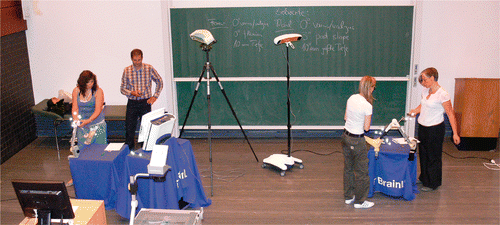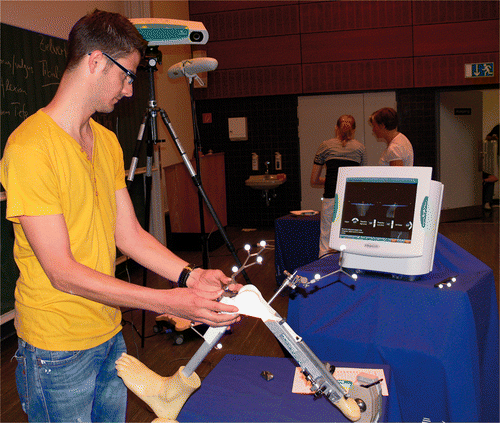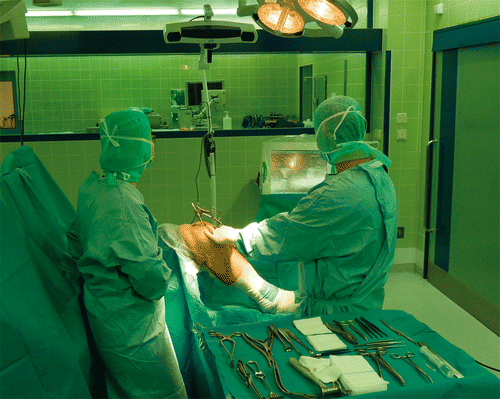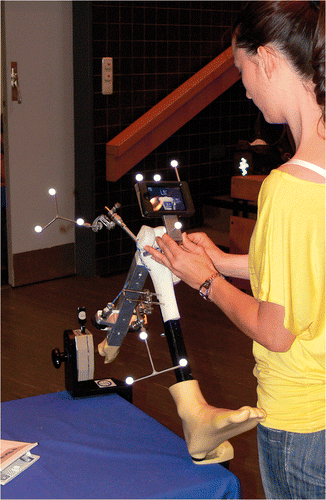Abstract
The use of computer navigation in total knee arthroplasty (TKA) improves the implant alignment but increases the operation time. Studies have shown that the operation time is further prolonged due to the surgeon's learning curve, and longer operation times have been associated with higher morbidity risks. It has been our hypothesis that an improvement in the human-machine interface might reduce the time required during the learning curve. Accordingly, we asked whether the use of navigation devices with a display fixed on the surgical instruments would reduce the operation time in navigated TKAs performed by navigation beginners.
Thirty medical students were randomized and used two navigation devices in rotation: these were the Kolibri® device with an external display and the Dash® device with a display that was fixed on the cutting blocks. The time for adjustment of the tibial and femoral cutting blocks on knee models while using these devices was measured.
A significant time reduction was demonstration when the Dash® device was used: The time reduction was 21% for the tibial block (p = 0.007), 40% for the femoral block (p < 0.001), and 32% for the whole procedure (p < 0.001).
The integrated display, fixed on surgical instruments in a manner similar to a spirit level, seems to be more user-friendly for navigation beginners. Hence, unproductive time losses during the learning curve may be diminished.
Introduction
In recent years, imageless computer navigation has become established as a standard implantation technique for total knee arthroplasty (TKA) Citation[1], Citation[2]. Proponents of computer navigation refer to meta-analyses that prove a significant reduction in alignment outliers with the use of navigation Citation[2–4]. It is also assumed that computer navigation may improve implant survival, as clinical studies indicate an increased incidence of revision if TKA prostheses are implanted with an axis deviation of more than 3° varus/valgus Citation[3–5]. However, critics emphasize that, because the technology is still quite new, no long-term results concerning implant survival and computer navigation are yet available Citation[6–8]. In addition, they highlight two disadvantages of computer navigation: First, navigation is associated with additional costs, calculated to be 300–450 € per operation Citation[1], Citation[9], Citation[10]. This extra cost is mainly the result of purchasing the navigation device, but also reflects the prolonged operation time, which represents the second disadvantage of computer navigation. Studies comparing conventional and navigated TKA indicate a prolongation of the operation time for navigation-trained surgeons of 7 to 15 minutes Citation[1], Citation[9], Citation[11–14]. However, several investigations have shown that, with respect to the operation time, there is a significant learning curve effect, leading to much longer operation times for untrained surgeons Citation[15–21]. A prolonged operation time has been associated with an increased incidence of postoperative infections Citation[22], wound complications Citation[23] and venous thromboembolic diseases Citation[24]. In summary, because of these elevated morbidity risks and with a view to the economic situation, attempts should be made to reduce the additional operation time needed for computer navigation. Particularly within the learning curve, the additional time required for computer navigation might be reduced by development of more user-friendly navigation devices. It was our hypothesis that the integration of the navigation display into the surgical field, by connecting it to the surgical jigs, might reduce the time required for computer navigation during the learning curve for navigated TKA.
Material and methods
Navigation devices
Two different types of imageless navigation devices were tested in this study: the Kolibri® device (Knee Essential® 2.1 software, BrainLAB, Feldkirchen, Germany) represents an imageless navigation device that shows the navigation data on an external display. The display is usually positioned to the side of the operation site on a navigation rack (). In contrast, the Dash® device (Dash Knee software, BrainLAB, Feldkirchen, Germany) uses a regular iPod touch (Apple, Cupertino, CA) as its display. The iPod is covered by a sterile drape and is fixed in a plastic cover. During the operative procedure the iPod is integrated into the sterile area like a surgical instrument, and can be fixed on the cutting blocks ().
Study design
We recruited an unselected group of 30 fourth-year medical students for this trial. Exclusion criteria were prior knowledge of computer navigation. All students were informed about computer navigation and the design of the study in a 30-minute talk, with all questions being answered to guarantee an equal level of knowledge. The students were asked to place the tibial and distal femoral cutting blocks for at least 2 seconds in a defined target position ± 1 mm/1° using both navigation systems. Target parameters for the tibial block were 0° axis, 3° slope, 10-mm resection depth of the higher side; for the femoral block they were 0° axis, 0° flexion, 10-mm resection depth. The students were informed that the duration of the procedure was being recorded.
Experimental set-up
The two navigation systems were arranged around two knee models (Endo Leg; Medical models, London, UK) to imitate the clinical situation in the operating theater (). The display of the Kolibri device was placed off to the side of the knee model (), while the Dash device was fixed on the cutting blocks themselves (). Identical reference arrays were fixed to the tibia and femur of both knee models. PFC Sigma HP cutting blocks (DePuy, Leeds, UK) were used for both procedures.
Figure 3. Overview of the study set-up. The Kolibri® device is shown on the left and the Dash® device on the right. Identical knee models with identical reference arrays were used at both workstations. The infrared cameras of both systems were positioned at the foot of the virtual patients.

Figure 4. A student adjusts the cutting blocks using the Kolibri® device. During the procedure, an optical array was fixed on the tibial and femoral cutting blocks.

The students were randomized and divided into two groups: The Kolibri group (n = 15) comprised 9 male and 6 female students with a mean age of 26 years (range: 22–33 years). The Dash group (n = 15) consisted of 7 male and 8 female students with a mean age of 25 years (range: 21–33 years). Each student in the Kolibri group started with a single set of adjustments of the tibial and femoral cutting blocks using the Kolibri device. The Dash group started with the same navigated procedures using the Dash system. Thereafter, the Kolibri group switched to using the Dash system, and the Dash group to using the Kolibri system. This course of navigated procedures was performed until each student had rotationally used both navigation systems 3 times. The following data were recorded: the time until the cutting block was adjusted within the above-mentioned target area; and the time between each set of navigated procedures with the Dash and Kolibri device.
Statistics
The data was tested for normality using the Kolmogorov-Smirnov test. As normality has not been proven, the Wilcoxon test was used to determine significance with a significance set at α = 0.05. The SPSS Statistics 18.0 software for Windows was used for statistical analysis.
Results
Analysis of the time required by the students for adjustment of the cutting blocks shows that in both groups there was a considerable learning curve: the time for adjustment of the cutting blocks with the Dash device decreased between the first and third trial from 106 seconds to 56 seconds in the Dash group and from 82 to 52 seconds in the Kolibri group. The time for adjustment of the instruments using the Kolibri device decreased from 141 seconds to 71 seconds in the Dash group and from 158 to 69 seconds in the Kolibri group. These data are summarized in . For further analysis, the mean values of the three trials were used ().
Table I. Time requirements for adjustment of cutting blocks for both groups.
Dash group. In the Dash group, for adjustment of the tibial block there was no significant time difference between the Dash and Kolibri devices (45 s vs. 49 s, p = 0.346). However, the orientation of the femoral block required significantly less time if the Dash device was used (36 s vs. 56 s, p = 0.005). Summation of the time required for both the tibial and femoral blocks resulted in a significant reduction if the Dash device was used (81 s vs. 105 s, p = 0.006).
Kolibri group. Adjustment of the tibial block as well as the femoral block required significantly less time if the Dash device was used (tibial block: 34 s vs. 53 s, p = 0.007; femoral block: 32 s vs. 58 s, p = 0.001). Summation of the time required for orientation of the tibial and femoral blocks resulted in significantly shorter delays if the Dash device was used (66 s vs. 110 s, p = 0.001).
Analysis of all students. Computer navigation of the tibial block required an average of 40 seconds using the Dash device and 51 seconds using the Kolibri device (p = 0.007). The adjustment of the femoral block required significantly less time if the Dash device was used (34 s vs. 57 s; p < 0.001). The average time for navigation of the tibial and femoral blocks with the Dash device was reduced by 32% in comparison to the Kolibri device (73 s vs. 108 s, p < 0.001; ). These data and the levels of significance are summarized in .
Figure 5. The total time requirement for adjustment of the tibial and femoral blocks. Using the integrated display (the Dash® device), the time requirement was significantly reduced by 32% (73 s vs. 108 s, p < 0.001).

Table II. Time for adjustment of each cutting block using the Dash and Kolibri devices.
Discussion
In recent years, computer navigation has continued to gain in popularity Citation[2], and many surgeons hitherto inexperienced in computer navigation have begun to use this technique. Several studies have shown that the additional time requirement for computer navigation is particularly increased for surgeons inexperienced in navigation: Jenny et al. compared a group of navigation beginners to a group of experts in 218 procedures and reported an additional operation time of 10 to 20 minutes for the beginners Citation[16]. Manzotti et al. showed an average extra time requirement for the first 25 operations of 10 minutes Citation[18], while Smith et al. identified a learning curve effect of 20 minutes for the first 20 navigated operations Citation[20]. Maniar et al. reported a difference of 8 minutes between early and late navigated procedures Citation[17], while Sampath et al. reported this time to be 15 minutes Citation[19]. Other studies reported a more extensively increased time demand of 44 to 61 minutes for navigated procedures Citation[6], Citation[21], Citation[25]. The above-cited studies used the most common type of navigation devices, which display the navigation data on an external monitor screen that is usually placed to the side of the operation site. It was our hypothesis that the visual transfer between the operation site and the external display might be one fundamental reason for the extended time needed during the learning curve. We therefore compared a common navigation device with an external display with another navigation device that integrated the display into the surgical site.
Our study indicated a 32% time saving for the adjustment of both cutting blocks if the integrated display was used. Individual analysis of the time required for the tibial and femoral blocks in each group shows that the sequence of the trial influenced the results considerably: The Dash group started with the adjustment of the tibial block and the Dash device. For this procedure they required significantly more time than the Kolibri group using the same device. The opposite effect was noted for the Kolibri group: They needed more time to adjust the tibial block with the Kolibri device than the Dash group did. We believe that this bias caused the similar time requirement for the tibial block in the Dash group while increasing the difference in the Kolibri group. However, as half the students started with the first navigation device and the other half with the second device, thereafter using both devices in rotation, we aimed to diminish this bias as much as possible. It was considered that the analysis of both groups together should counterbalance the effect caused by the sequence of the trials. The statistical analysis showed homogenous results: Use of the integrated display significantly reduced the time required for adjustment of the tibial block by 21%, the time required for adjustment of the femoral block by 40%, and the time for the whole procedure by 32%. We therefore believe our results to be sustainable.
Further analysis of the way the students used both navigation systems might explain these time differences: When using the navigation device with the external display, students watched the display during the alignment of the cutting blocks ( and ). As the display was positioned off to the side of the knee models, the surgical site was not in their visual field during the adjustment procedure. The visual feedback that would normally be used if a jig is being adjusted is thus missing in this workflow. In summary, the visually identified target position on the display has to be converted into a tactual adjustment of the cutting blocks. A different human-machine interface was established by use of the integrated display. As this display was fixed on the cutting blocks themselves, the visual field of the students included the surgical site, the cutting blocks and the navigation display (). The cutting block was adjusted in a similar manner to a spirit level, and the transfer between the display and the position of the cutting block seemed to be easier. To our knowledge, no other study has yet examined the effect of different human-machine interfaces on the learning curve in computer navigation. The only study dealing with a reduction in the time requirement during the learning curve used an additional surgeon to handle the navigation device Citation[25], and that group reported a time reduction of 34 minutes in 40 cases if a well-trained additional surgeon served as a “navigator” to manage the navigation device. However, from our point of view, the approach to shortening the time requirement for computer navigation should involve improvements in usability rather than additional staff requirements.
Our study design schedule called for the adjustment of each cutting block and navigation device three times in rotation. Between the first and third trials a notable learning curve with a time-reduction of up to 57% was observed. Different studies have shown the learning curve in a clinical setting to be much flatter: Sampath et al. Citation[19] reported a continuous time reduction of 15 minutes over a period of 172 operative procedures, while Jenny et al. showed a time delay between navigation beginners and experts of up to 20 minutes, which was reduced to 7 minutes after 218 navigated TKA procedures Citation[16]. Therefore, it is a limitation of our study that we measured a too-steep learning curve. We believe that the use of the identical knee model 6 times within 2 hours caused this effect: The familiarization with the knee model by optical and tactile feedback mechanisms and the absence of soft tissue and pathologic deformity might have influenced the learning curve. As this effect was identical in both groups, from our point of view it should not influence the results of our trial substantially. Another limitation of our study is that we did not measure the operation times for the whole procedure but only for the adjustment of the cutting blocks. It is common sense that there are a variety of pitfalls during navigated TKA, each able to cause time loss. However, it was the aim of our study to focus on the machine-human interface, represented by the use of different displays. We therefore decided to exclude the other steps of the operation to anticipate further influences on our results. The displays mounted on the cutting blocks represent only one fragment of the Dash® concept. In this concept, the display is integrated into the surgical field and attached to surgical instruments. For instance, the Dash® display acts as a pointer for the registration process: a plastic tip is connected to the display and acts as a surgical instrument with an integrated display. In combination with a reduced number of required registration steps, these new instruments might simplify and thereby accelerate the registration procedure. Thus, the time savings measured in seconds in our experiment might represent only a part of the overall time-saving potential of integrated displays.
With a view to the additional time that even navigation experts need for computer navigation as compared to the conventional technique, meta-analysis has identified a time requirement of 7 to 15 minutes Citation[1], Citation[9], Citation[11–14]. These additional minutes are to some extent caused by the registration procedures, but mainly result from checking the accuracy of bony resections and ligament balancing procedures, so that errors in resection or ligament balancing can be noticed and corrected. Therefore, this additional time requirement is mainly a positive factor which results in improved implant alignment. In contrast, the additional time requirement during the learning curve is completely useless: it is caused by unfamiliar workflows and low usability of the navigation devices and hence produces no benefit for the patient; on the contrary, it elevates exclusively perioperative morbidity risks and the costs of the procedure Citation[1], Citation[9], Citation[10], Citation[22–24].
Conclusion
Our study has identified the human-machine interface between the surgeon and the navigation display as being time-critical. Unproductive time loss was generated if a navigation device with an external display was used, whereas a time reduction of 32% was achieved if an integrated display fixed on the cutting blocks was used. We therefore conclude that the integrated display, fixed on surgical instruments in a manner similar to a spirit level, seems to be more user-friendly for navigation beginners. Unnecessary time losses during the learning curve may thus be diminished. Prospective in vivo studies are necessary to further evaluate this effect.
Acknowledgments
We thank the students who participated in this study. We also thank BrainLAB for providing the navigation devices and the support for this study, and DePuy for providing the cutting blocks for the trials.
Declaration of interest: Each student received an allowance of 20€ for participation in the study. There was no further funding or conflict of interest. The study design, the results and their interpretation have not been influenced by any company.
References
- Cerha O, Kirschner S, Günther KP, Lützner J. [Cost analysis for navigation in knee endoprosthetics] [in German]. Orthopade 2009; 38: 1235–1240
- Brin YS, Nikolaou VS, Joseph L, Zukor DJ, Antoniou J. Imageless computer assisted versus conventional total knee replacement. A Bayesian meta-analysis of 23 comparative studies. Int Orthop 2011; 35: 331–339
- Bäthis H, Shafizadeh S, Paffrath T, Simanski C, Grifka J, Lüring C. [Are computer assisted total knee replacements more accurately placed? A meta-analysis of comparative studies] [in German]. Orthopade 2006; 35: 1056–1065
- Mason JB, Fehring TK, Estok R, Banel D, Fahrbach K. Meta-analysis of alignment outcomes in computer-assisted total knee arthroplasty surgery. J Arthroplasty 2007; 22: 1097–1106
- Fang DM, Ritter MA, Davis KE. Coronal alignment in total knee arthroplasty: Just how important is it?. J Arthroplasty 2009; 24: 39–43
- Bonutti PM, Dethmers D, Ulrich SD, Seyler TM, Mont MA. Computer navigation-assisted versus minimally invasive TKA: Benefits and drawbacks. Clin Orthop Relat Res 2008; 466: 2756–2762
- Callaghan JJ, Liu SS, Warth LC. Computer-assisted surgery: A wine before its time: in the affirmative. J Arthroplasty 2006; 21(4 Suppl 1)27–28
- Dattani R, Patnaik S, Kantak A, Tselentakis G. Navigation knee replacement. Int Orthop 2009; 33: 7–10
- König DP, Michael JW, Eysel P, Münnich U, Lichtenstein T, Schnurr C, [Computer-assisted joint replacement surgery. Financial and clinical impact for a specialised orthopaedic hospital] [in German]. Z Orthop Unfall 2009;147:669–674
- Novak EJ, Silverstein MD, Bozic KJ. The cost-effectiveness of computer-assisted navigation in total knee arthroplasty. J Bone Joint Surg Am 2007; 89: 2389–2397
- Chauhan SK, Scott RG, Breidahl W, Beaver RJ. Computer-assisted knee arthroplasty versus a conventional jig-based technique. A randomised, prospective trial. J Bone Joint Surg Br 2004; 86: 372–377
- Haaker RG, Stockheim M, Kamp M, Proff G, Breitenfelder J, Ottersbach A. Computer-assisted navigation increases precision of component placement in total knee arthroplasty. Clin Orthop Relat Res 2005; (433): 152–159
- Lützner J, Krummenauer F, Wolf C, Günther KP, Kirschner S. Computer-assisted and conventional total knee replacement: A comparative, prospective, randomised study with radiological and CT evaluation. J Bone Joint Surg Br 2008; 90: 1039–1044
- Matziolis G, Krocker D, Weiss U, Tohtz S, Perka C. A prospective, randomized study of computer-assisted and conventional total knee arthroplasty. Three-dimensional evaluation of implant alignment and rotation. J Bone Joint Surg Am 2007; 89: 236–243
- Bonutti PM, Dethmers DA, McGrath MS, Ulrich SD, Mont MA. Navigation did not improve the precision of minimally invasive knee arthroplasty. Clin Orthop Relat Res 2008; 466: 2730–2735
- Jenny JY, Miehlke RK, Giurea A. Learning curve in navigated total knee replacement. A multi-centre study comparing experienced and beginner centres. Knee 2008; 15: 80–84
- Maniar RN, Johorey AC, Pujary CT, Yadava AN. Margin of error in alignment: A study undertaken when converting from conventional to computer-assisted total kee arthroplasty. J Arthroplasty 2011; 26: 82–87
- Manzotti A, Cerveri P, De Momi E, Pullen C, Confalonieri N. Relationship between cutting errors and learning curve in computer-assisted total knee replacement. Int Orthop 2010; 34: 655–662
- Sampath SA, Voon SH, Sangster M, Davies H. The statistical relationship between varus deformity, surgeon's experience, BMI and tourniquet time for computer assisted total knee replacements. Knee 2009; 16: 121–124
- Smith BR, Deakin AH, Baines J, Picard F. Computer navigated total knee arthroplasty: The learning curve. Comput Aided Surg 2010; 15: 40–48
- Yasunaga H, Tsuchiya K, Matsuyama Y, Ohe K. Analysis of factors affecting operating time, postoperative complications, and length of stay for total knee arthroplasty: nationwide web-based survey. J Orthop Sci 2009; 14: 10–16
- Peersman G, Laskin R, Davis J, Peterson M. Infection in total knee replacement: A retrospective review of 6489 total knee replacements. Clin Orthop Relat Res 2001; (392): 15–23
- Vince K, Chivas D, Droll KP. Wound complications after total knee arthroplasty. J Arthroplasty 2007; 22: 39–44
- Lieberman JR, Hsu WK. Prevention of venous thromboembolic disease after total hip and knee arthroplasty. J Bone Joint Surg Am 2005; 87: 2097–2112
- Windhagen H, Thorey F, Ostermeier S, Emmerich J, Wirth CJ, Stukenborg-Colsman C. [Navigator concept. Optimizing the procedure for navigated total knee arthroplasty] [in German]. Orthopade 2005; 34: 1125–1130

